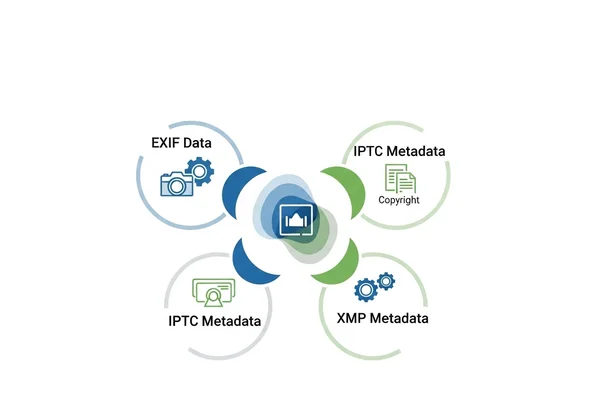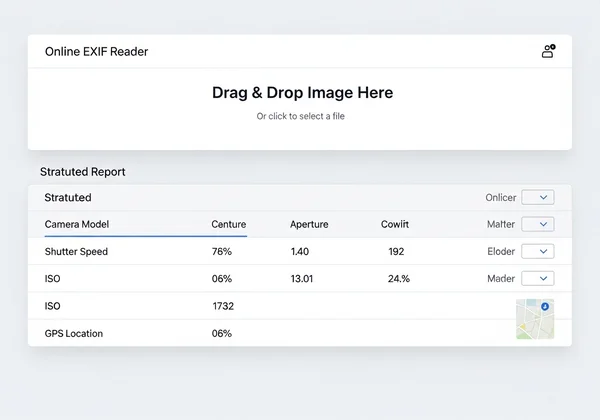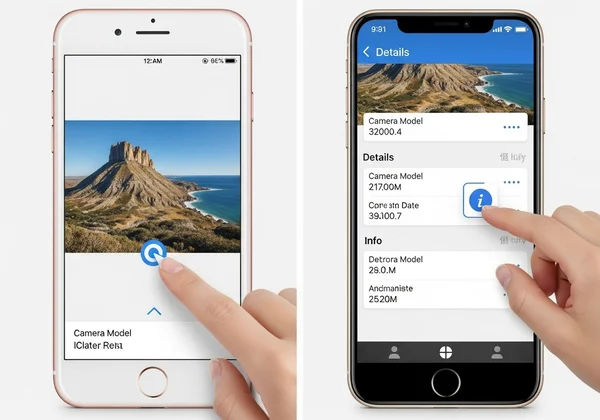View Photo Metadata: Ultimate EXIF, IPTC & XMP Guide
Every picture tells a story, but what hidden details does it reveal? Beyond what meets the eye, images often contain a treasure trove of technical and potentially sensitive information. This hidden data, known as photo metadata, is crucial for photographers, digital content creators, and anyone concerned about their online privacy. How to read EXIF data and other metadata types can seem complex, but this ultimate guide will demystify it, explaining why it matters and how you can easily view it on any device using privacy-first tools like our online EXIF reader. Unlock your image secrets today!
What is Photo Metadata? Understanding EXIF, IPTC, and XMP
Photo metadata refers to embedded information within an image file. It’s essentially data about the data, providing context, history, and technical specifics. While often invisible to the naked eye, understanding these standards is key to managing your digital assets and protecting your privacy.
EXIF Data: Your Camera's Digital Fingerprint
EXIF data (Exchangeable Image File Format) is perhaps the most common type of image metadata. When you snap a photo with your digital camera or smartphone, a wealth of technical details is automatically recorded and embedded directly into the image file. This includes everything from the camera model and lens used to specific shooting parameters like aperture, shutter speed, ISO speed, focal length, and even the date and time the photo was taken. For many images, it also includes GPS data, revealing the exact location where the picture was captured. This exif data reader functionality is invaluable.
IPTC Metadata: Information for Professionals & Publishers
IPTC metadata (International Press Telecommunications Council) is primarily used by news agencies, photographers, and other media professionals. Unlike EXIF, which focuses on technical camera settings, IPTC is more about descriptive and administrative information. This can include copyright notices, photographer's contact information, captions, keywords, categories, and even instructions for usage rights. It helps in asset management and ensuring proper attribution for professional images.
XMP Metadata: The Versatile & Extensible Standard
XMP metadata (Extensible Metadata Platform) is a newer, more flexible standard developed by Adobe. It's designed to be easily extensible, meaning it can store a wider variety of custom data, including information traditionally found in both EXIF and IPTC. XMP is often used for non-destructive edits in software like Photoshop and Lightroom, keeping a record of changes without altering the original image data. Its versatility makes it a powerful image metadata viewer standard for complex workflows.

Why Checking Image Metadata Matters for You
Understanding and checking image metadata goes beyond technical curiosity. It's a critical practice for security, professional integrity, and creative insight. Many users want to check EXIF data for various reasons.
For Privacy-Conscious Users: Safeguarding Personal Location Data
Perhaps the most significant reason to check your image metadata, especially for the average user, is privacy. Your smartphone photos frequently embed GPS coordinates, potentially revealing your home address, workplace, or travel routes. Sharing these photos online without checking first can inadvertently expose sensitive personal information. If you're wondering does EXIF data show location, the answer is often yes, and using a reliable tool is key to finding and managing this data. Safeguarding your personal location data is simple with the right online tools.

For Photographers: Learning from Camera Settings & Post-Processing
For aspiring and professional photographers, view EXIF data is a powerful learning tool. By analyzing the camera settings of your favorite shots—or even those you wish to improve—you can understand how different aperture, shutter speed, and ISO combinations impact the final image. It's like looking over the shoulder of a master. Moreover, reviewing your own EXIF data helps you refine your shooting techniques and learn from past successes and mistakes. Use a robust EXIF viewer online to gain quick insights.
For Digital Content Creators: Copyright & Asset Management
Digital content creators and social media managers often deal with a vast library of images. IPTC metadata and XMP can hold crucial copyright information, creator credits, and licensing details. Checking this data ensures proper attribution when using images and helps protect your own work from misuse. It's an essential step in maintaining legal compliance and professional standards for your visual assets.
For Forensics & Verification: Unveiling Image Provenance
For technical experts or those involved in digital forensics, metadata can be invaluable. It provides a digital trail, offering clues about an image's origin, creation date, and even whether it has been tampered with. This can be critical for verifying the authenticity of photos in legal cases, investigations, or journalistic endeavors. A reliable image EXIF viewer can be the first step in such analyses.
How to View Photo Metadata Online Safely & Easily
While many desktop programs offer metadata viewing, online tools provide unparalleled convenience and accessibility. The key is choosing one that prioritizes your privacy.
Our Tool: Your Go-To Privacy-First Online Viewer
When it comes to viewing photo metadata online, our tool stands out as a premier free EXIF viewer. Our core commitment is to your privacy and security. Unlike many other online tools that require you to upload your image files to a server, our image metadata viewer performs all processing directly within your web browser. This means your photos never leave your computer, eliminating any risk of data breaches or privacy concerns. It's an online EXIF reader built for your peace of mind.
Step-by-Step: Using Our Tool to Unveil Image Secrets
Using our tool is incredibly straightforward, designed for maximum user-friendliness.
- Visit our homepage: Navigate to our website.
- Upload Your Image: Simply drag and drop your image file into the designated area on the page, or click to select a local file from your device.
- Instant Analysis: Our JavaScript-powered tool immediately reads and parses the image data right in your browser. No waiting for uploads to external servers.
- View Your Metadata: Within moments, a clear, structured report of all extracted metadata will appear on your screen. You can scroll through and analyze basic information, GPS data, camera settings, and even manufacturer-specific notes.
This simple process makes it easy to read EXIF data and other hidden details. For a quick look at your photos, discover your results instantly.

Why Online Tools Are Often the Best Choice (Privacy & Convenience)
Online EXIF reader tools offer several advantages. They are cross-platform, meaning you can use them on any operating system without installing software. This makes them ideal for quick checks on the go. Furthermore, tools like ours, with their client-side processing, offer a level of privacy that traditional desktop software might not explicitly highlight. For quick checks, simply opening your browser and dropping a file to view EXIF data makes online tools an unparalleled choice.
Viewing EXIF & Image Metadata on Desktop Computers
While online EXIF reader tools like ours offer superior privacy and convenience, you can also access basic metadata on your desktop.
On Windows: File Properties & Third-Party Apps
On Windows, you can perform a basic check EXIF data by right-clicking on an image file, selecting "Properties," and then navigating to the "Details" tab. This will show you a summary of EXIF data Windows properties, including camera model, date taken, dimensions, and sometimes GPS coordinates. For more detailed analysis, dedicated EXIF data viewer applications are available for download.
On macOS: Using Preview and Dedicated Software
macOS users can easily view EXIF data using the built-in Preview application. Open an image in Preview, then go to "Tools" > "Show Inspector" (or click the 'i' icon in the toolbar). In the Inspector window, click the "(i)" tab (for Information) and then select the "Exif" tab. This will display a comprehensive list of the image's EXIF data on Mac. For advanced photo metadata viewer needs, third-party apps provide deeper insights.
Accessing Photo Metadata on Mobile Devices (iPhone & Android)
Mobile devices are where most photos are taken, and checking their metadata is just as important. EXIF mobile data is usually readily available.
For iPhone Users: Built-in Features & Apps
For iPhone users, how to view EXIF data on iPhone has become easier with recent iOS updates. Open the Photos app, select an image, and swipe up to see basic details like camera, lens, and location (if enabled). For a more comprehensive EXIF data reader experience, numerous third-party apps are available on the App Store that specialize in displaying detailed metadata, including comprehensive GPS maps and camera settings.
For Android Users: Gallery Apps & Metadata Viewers
On Android, the process for how to view EXIF data on Android varies slightly depending on your phone's manufacturer and gallery app. Many default gallery apps allow you to tap on an image, then look for an "info," "details," or "properties" option (often a small 'i' icon or three dots menu). This will usually display capture date, dimensions, and sometimes basic camera settings. For an in-depth image metadata viewer experience, a wide range of free and paid EXIF viewer apps are available on the Google Play Store.

Empowering Your Photo Journey with Metadata Insights
From safeguarding your privacy to refining your photography skills or verifying digital assets, understanding and checking image metadata is a powerful capability. While desktop and mobile devices offer some native viewing options, online tools like ours offer the most convenient, accessible, and, most importantly, private way to view photo metadata.
We encourage you to make it a habit to check your images before sharing them online. Dive deeper into your photos and unveil image secrets with confidence and security. Ready to explore? Try our free tool today and take control of your image data.
Frequently Asked Questions About Image Metadata & Viewing
What is the best free EXIF viewer?
For online EXIF data viewer needs that prioritize privacy and ease of use, our online EXIF viewer is widely considered among the best free options. It processes images directly in your browser, ensuring your files never leave your device. For desktop or mobile, various free apps offer similar functionalities, but none match the universal accessibility of a web-based tool. You can check your data now with no installation required.
Does EXIF data show location, and how can I find it?
Yes, does EXIF data show location is a critical question for privacy. Many smartphones and digital cameras embed GPS coordinates into the EXIF data of photos by default. You can find this information using a dedicated online EXIF reader like ours. Simply upload your photo, and if location data is present, it will be displayed in the detailed report.
Does Facebook or Instagram remove EXIF data when I upload photos?
Generally, social media platforms like Facebook and Instagram do remove EXIF data (including GPS location and camera settings) from uploaded photos to protect user privacy and reduce file sizes. However, this is not a universal guarantee for all platforms, nor does it apply to photos you send directly to others. It's always best practice to check EXIF data yourself before sharing, especially sensitive images.
Do screenshots have EXIF data or other hidden metadata?
Typically, screenshots do not have EXIF data in the same way photos taken by a camera do. They usually lack camera settings, GPS information, or timestamps embedded within the image file itself. However, screenshots may still have some basic metadata generated by the operating system, like the creation date of the file on your computer.
How can I find the original metadata of a photo I received?
If you receive a photo, its original metadata might still be intact, especially if it was sent via direct message or email. Social media platforms often strip metadata upon upload, but direct sharing methods may retain it. To find the original metadata, you can use an image metadata viewer like ours. Just open the image with the tool, and it will display all available hidden information, helping you read EXIF data from any source.